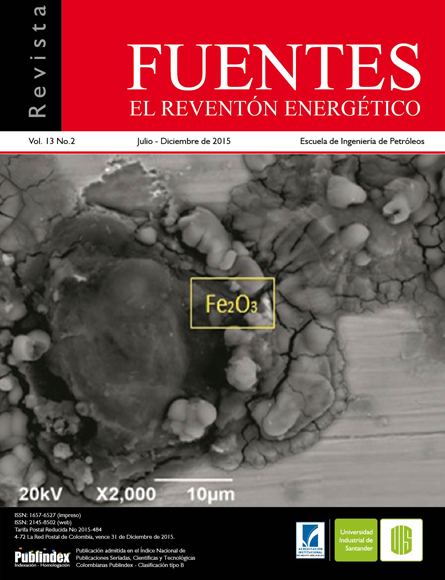Application of adsorption isotherm models of methane on a shale sample and their impact on reserves estimation
Published 2015-12-03
Keywords
- Shale,
- Gas,
- Reservoir,
- Isotherms,
- Adsorption
How to Cite
Abstract
Several adsorption isotherm models were analyzed for the purpose of fi tting the experimental data published by Gasparik et al. (2012) obtained in a methane adsorption experiment on a shale sample from the Posidonea formation in the netherlands. the following are the ten models used in this study; some of them consist of two parameters such as Langmuir, temkin and freundlich, the three parameter models: Langmuir, DubininRadushkevich, Toth and Sips, four parameters: Dubinin-Astakhov and Fritz-Schlunder and the fi ve-parameter Fritz Schlunder correlation. The results show a better fi t to the experimental data for those models with the highest number of parameters.
Subsequently, The total gas storage capacity in a hypothetical formation was calculated using some data of the Posidonea formation and the methodology proposed by Ambrose et al (2010), which was modified afterwards by substituting the term taking into account the adsorbed gas for the models mentioned earlier in this article in order to determine their influence in the free and adsorbed gas calculations. In this way, the models with the lowest Average Percentage Error (APE) generally calculated a lower volume of adsorbed and total gas compared to those models with the highest APE, which indicates the importance of a proper model selection for calculating reserves, since it implies high technical and economic impact.
Downloads
References
2. AKHTAR, Arshia; KHAN, Md. Dilwar Alam and NABI, S.A. Ion Exchange Kinetics and Equilibrium Studies of Metal Ions Onto a Hybrid Cation Exchanger: Polyaniline–Sn(Iv)Tungstophosphate. En: International Journal of Engineering Sciences & Research Technology. January, 2015. vol. 4, no. 1, p. 89-98.
3. AMBROSE, Ray J., HARTMAN, Robert C., DIAZ CAMPOS, Mery, AKKUTLU, I. Yucel, SONDERGELD, Carl H. Shale Gas-in-Place Calculation Part I: New Pore-Scale Considerations. En: SPE Unconventional Gas Conference (23-25 February, 2010: Pittsburgh, Pennsylvania). SPE 131772, p. 219-229.
4. CLARKSON, C. R.; BUSTIN, R. M. and LEVY, J. H. Application of the Mono/Multilayer and Adsorption Potential Theories to Coal Methane Adsorption Isotherms at Elevated Temperature and Pressure. En: Carbon. 1997, vol. 35, no. 12, p. 1689- 1705.
5. DADA, A.O., OLALEKAN, A. P., OLATUNYA, A. M., DADA, O. Langmuir, Freundlich, Temkin and Dubinin–Radushkevich Isotherms Studies of Equilibrium Sorption of Zn2+ Unto Phosphoric Acid Modified Rice Husk. En: Journal of Applied Chemistry. 2012, vol. 3, no. 1, p. 38-45.
6. ETMINAN, S. Reza, JAVADPOUR, Farzam, MAINI, Brij B., CHEN, Zhangxin. Measurement of gas storage processes in shale and of the molecular diffusion coefficient in kerogen. En: International Journal of Coal Geology. October, 2013. No. 123, p. 10-19.
7. GASPARIK, M., GHANIZADEH, A., BERTIER, P., GENSTERBLUM, Y., BOUW, S., and KROSS, Bernhard M. High-Pressure Methane Sorption Isotherms of Black Shales from The Netherlands. En: Energy and Fuels American Chemical Society. July 5, 2012, vol. 26, p. 4995−5004.
8. HAMDAOUI, Oualid, NAFFRECHOUX, Emmanuel. Modeling of Adsorption Isotherms of Phenol and Chlorophenols onto Granular Activated Carbon Part Ii. Models with More Than Two Parameters. En: Journal of Hazardous Materials. 2007, vol. 147, no. 1-2, p. 401–411.
9. HARTMAN, Robert C., AMBROSE, Ray J., AKKUTLU, I. Yucel, CLARKSON, C.R. Shale Gas-in-Place Calculation Part II: Multi-Component Gas Adsorption Effects En: SPE Unconventional Gas Conference (14-16 June, 2011: Woodlands, Texas). SPE 144097, p. 2-17.
10. LOGANATHAN, Sravanthi, TIKMANI, Mayur, GHOSHAL, Aloke Kumar. Pore-expanded MCM41 for CO2 adsorption: Expermiental and isotherm modeling studies. En: Chemical Engineering Journal. June, 2015, no. 280, p. 9-17.
11. MENGAL, Salman A. y WATTENBARGER, R. A. Accounting for Adsorbed Gas in Shale Gas Reservoirs. En: Spe Middle East Oil and Gas Show and Conference. (25-28, September, 2011: Manama, Bahrain). Texas A&M University, 2011. p. 1-15.
12. ROUQUEROL, F. ROUQUEROL, J.; SING, K.S.W.; LLWELLYN, P. and MAURIN, G. Adsorption by Powders and Porous Solids: Principles, Methodology and Applications. 2nd Ed. Marseilles: Academic Press, 2014, p.1-626.
13. SIPS, Robert. On the Structure of a Catalyst Surface. En: The Journal of Chemical Physics, Volume 16, Issue 5, 1948, p.490-495.
14. SUBRAMANYAM, B. and ASHUTOSH, D. Adsorption Isotherm Modeling of Phenol onto Natural soils – Applicability of Various Isotherm Models. En: International Journal of Environmental Research. 2011, vol. 6, no. 1, p.265-276.
